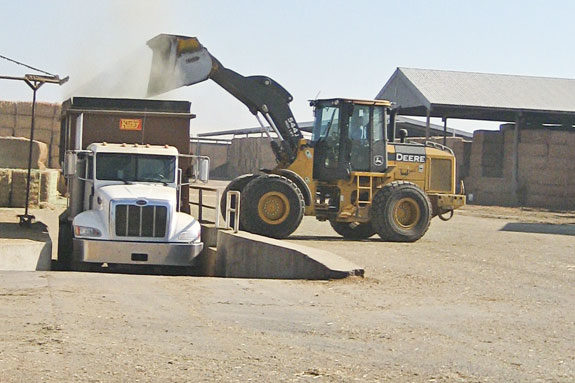To understand the right order of ingredients that should go into the mixer wagon, we must consider the physical properties of the ingredients that affect mixing, such as size, shape, density, water absorption capacity (hydroscopy), static electricity and adhesiveness. Ingredient moistureDry ingredients of small particle size will stick to high-moisture ingredients such as silage or molasses. Therefore, it is important to properly mix the dry ingredients before adding the wetter ingredients.
Just consider the order of ingredients you follow when baking a cake at home. First, you start with flour because it is added in the largest quantity and it is a dry ingredient. After that, you may add sugar and, finally, you add yeast or other dry ingredients incorporated in small amounts. Last, you add the sticky ingredients like oil or eggs.
Ingredient density
Heavier ingredients will sink and lighter ingredients will float. Corn silage is 33 percent denser than alfalfa silage, and the mineral mix can be two or three times denser than the protein or grain mix.
Low-density ingredients with long particle length, such as hay, should be added first followed by high-density ingredients of small particle size that will sink.
The different physical properties of the ingredients included in the cow’s ration makes it very difficult to obtain a uniformly mixed ration, especially using the simple auger design of most mixer wagons. Many dairy producers use manufactured feeds from feed mills or prepare their own premixes to ensure that grains, protein mix, byproducts, minerals and feed additives are mixed correctly.
Interestingly, in a study conducted to evaluate the mixing uniformity of manufactured premixes, it was found that only 50 percent of the samples had an acceptable coefficient of variation (CV) of less than 10 percent; however, 20 percent of the samples had a CV higher than 30 percent.
Comparing the equipment used on-farm with equipment used in feed mills, we could assume that on-farm premixes are even less uniform than those from feed mills. The implications of premixes with high CV is that cows may not be eating the same proportion of ingredients in each mouthful, and some expensive ingredients such as heavy minerals may not be uniformly distributed throughout the feedbunk.
Mixing forages with grains, protein mixes, byproducts, minerals and feed additives is an even greater challenge. Depending on the brand and type of the mixer wagon, the manufacturer will recommend the most desirable ingredients’ order to prepare the TMR.
Most vertical mixer wagons allow the incorporation of unprocessed hay that should be added as first ingredient, but the mixing time should be carefully controlled to ensure that the particle length is not excessively reduced. Although the horizontal mixer auger wagons equipped with knives also allow for the incorporation of unprocessed hay, the uniformity of mixing may be better when hay has been previously processed.
If there are no manufacturer’s specifications available, the following mixing protocol should be considered:
1. Long hay that needs to be processed.
2. If further processing of forages (hay or silage) is not desired, add first grains or premixes, followed by those ingredients that are incorporated in small amounts such as minerals and vitamins.
3. Forages that do not need to be processed.
4. Liquids should be the last ingredients.
However, only after conducting several on-farm trials with different ingredient sequences could we recognize the most desirable order of ingredients to obtain a uniformly mixed ration. EL
—Excerpts from the February 2012 California Dairy Newsletter.
A dairy producer approached me with the following question: “All my hay is chopped. If I add hay as the first ingredient in the TMR, I end up overprocessing it. However, if I add it last, it floats and does not mix. What should I do?”
The hay mixing problems described by the dairy producer could be resolved by:
• Decreasing the chopping action of the mixer by taking out some knives. However, if the mixer is used to prepare other rations, this might not be a practical solution.
• Increasing hay’s density by either soaking it with water or molasses or pre-mixing it with wetter ingredients like silages.
• Preparing a premix with all the TMR ingredients but hay, adding hay as the first ingredient and then the premix.

Noelia Silva-del-Río
Dairy adviser, UCCE Tulare County







